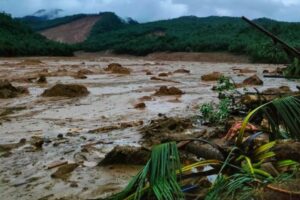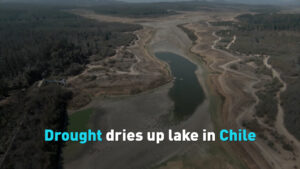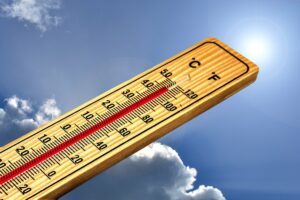The climate has become unstable. Scientists warned us for decades. Now even they are rebelling. We talk with Scientist Rebellion’s William Livernois. And Brian Ancell exposes another wrinkle nobody planned on: flash droughts. Alex reports on extreme climate-driven weather around the world.
Listen to or download this Radio Ecoshock show in CD Quality (57 MB) or Lo-Fi (16 MB)
Welcome to extreme world
Killer droughts, killer rain, and deadly heat events are rising up too fast for news to report. We skim across the headlines of lost homes, lost lives, broken economies and now they know, from the President to people in the slums: it is climate change.
But first, let’s take a tour of some damage zones shall we? Maybe you saw the news on the Durban floods. In South Africa Durban is a major port. As you will hear from news reports, that port is out of action, cut off by flood damage, with shipping containers washed up all around the dock area. Visiting the flood area, where over 450 people died, South African President Cyril Ramaphosa blamed the extreme rainfall squarely on climate change. This is what happens when countries in the north continue burning fossil fuels. The extreme rains around Durban are yet another shocking event blaring out warnings of the road we are all on.
EAST AFRICA CRUDE PIPELINE
While we are in Africa, I have more details for you on that giant East Africa Crude Pipeline raised last week by 350.org activist Nicholas Haeringer.
It is officially called The East African Crude Oil Pipeline (EACOP), but is sometimes called the Uganda–Tanzania Crude Oil Pipeline. It will take crude oil from Uganda to the Port of Tanga Tanzania on the Indian Ocean. The second largest owner after the French oil giant TotalEnergies is China National Offshore Oil Corporation, the government-owned company. Once again, China is involved in funding fossil fuel infrastructure in Africa.
Due to the sluggish nature of crude oil, the whole 900 mile pipeline has to be heated, even in Africa. It cuts across all sorts of farmland and wetlands, including along the famous Lake Victoria Basin. Various environment groups are fighting this climate killing project. ClimateNexus reports that major insurers are refusing coverage for the pipeline, citing concerns about climate change.
You may remember East Africa was hit with double back-to-back cyclones that ripped up the coastline. In fact, “in Madagascar, Mozambique and Malawi, […] a record three tropical cyclones hit within just six weeks of each other earlier this year, killing a combined 230 people and displacing hundreds of thousands.”
A new report from Worldweatherattribution.org shows climate change is making tropical cyclones worse. Extreme rainfall becomes more and more common as we heat the planet. It is already happening. The East Africa Crude Oil Pipeline will contribute even more greenhouse gases to bring even worse cyclones to that very same coast. We blindly build on – to wreck the future.
Tropical Storm Ana kills dozens in Malawi, Madagascar and Mozambique – BBC News
48,643 views Feb 3, 2022 BBC
FLOODS IN AUSTRALIA – AGAIN!
People were drowned and evacuated this April on the other side of the world, in Eastern Australia. The story here, which we hear in South Africa, and so often on newscasts anywhere from China to Europe: they got a month of rain overnight, or a year’s worth of rain in two days. These extreme rains are fast, just like the fast droughts we will hear about later.
It was just a month previous, early March 2022, when Reuters reported, quote: “The country’s east coast has been battered by a severe weather system that has cut off entire towns and submerged hundreds of homes and farms as it has moved south from Queensland state over the past week. Parts of Sydney and some neighboring regions are forecast to get a month’s rainfall on Thursday.”
And now it’s back, with still more extreme rains battering Australia, one of the world’s biggest coal exporters. Funny that. Could it be…. ???
PHILIPPINES: CYCLONE AND LANDSLIDES
In the same mid-April, the Philippines were smashed by another tropical cyclone. This was Tropical Storm Megi, also called Agaton. According to reliefweb international there were 407 flooded areas, 43 rain-induced landslides, 6 flash floods, affecting 237,864 families, meaning 688,539 people.

Image: Al Jazeera
The Philippines are long-known for tropical cyclones, but they have become more powerful in the last decade. Scientists suggest such storms will become even stronger during the coming years and decades, because of global warming.
IN OTHER PLACES: SEVERE DROUGHT
Way back when I started Radio Ecoshock, in 2006 climate scientists used the mantra: under climate change, “the wet areas get wetter, the dry get drier”. If we just focus on flood news, we miss something worse.
The latest case missing from headline news is the horrible drought in Kenya. In this show I broadcast a short report from PBS Newshour, from January 2022. There was a brief rain since then, but the drought continues.
CHILE!
But the grand-daddy of drought you’ve never heard about is in Chile. The capital city of Santiago is drawing plans for water rationing. Farming, including fabulous grape and wine making, is dying all along the coast of Chile. So many great mountain glaciers have melted and gone. The country is hotter, and so, so much drier.
So part of Chile have become a different place. River beds are dry. Green hills are now desert. Some farms are deserted. Politicians in Chile now realize these are not a few dry years. Climate change has shifted the country into a new dry zone, and the government has to accept and deal with an impoverished environment. (Image credit: CGTN China Global Television Network)

But they tell us we need, NEED more fossil fuels, to get “us” through the next year, the next decades. One of the world’s largest oil companies, Exxon just announced another $10 billion dollar investment in offshore oil. They are dealing with tiny Guyana, a sliver of a country along the north coast of South America, on the Atlantic Ocean. Exxon wants over a million barrels a day from their offshore platforms there. That means Lots more global warming for everybody – but profits for Exxon shareholders only. Guyana is reportedly also considering forming a national oil company. Either way, we need to leave those fossil fuels under the ocean, and not in the atmosphere.
SUPER HOT TIMES IN INDIA AND PAKISTAN

Just before we get to our first guest, the catalog of climate disasters in the last few weeks cannot be complete without heat. No, I am not talking about the record-tying 88 degrees recorded at the airport in Newark New Jersey on April 14th. That is the hottest it’s ever been there, but Atlantic City Airport hit 89 degrees in April 2021. Sure it is hotter in New Jersey in April than it used to be. That would be a summer day there a few decades ago.
For real, deadly heat, definitely extreme climate, we go to northern India this April 2022. This is the hottest April recorded in northern India in the last 72 years. It was also the warmest March in India in the last 122 years of records. The temperature in New Delhi reached 41.8 degrees Celsius, or 107 degrees Fahrenheit, on April 11. This heat wave is unusually early. Extra forest fires have broken out across northern India. Crops in some places are in doubt, unless the Monsoon rains come soon. I play a brief report from the Indian branch of downtoearth.org.in Pakistan is also suffering a weird early heat wave, coming in spring instead of summer.
===================================================
WHY YOUNG SCIENTISTS ARE REBELLING
Suppose you want to be a scientist. It may take seven years to get a Doctorate. A student on that route today comes to realize, by the time I graduate in 2030, the world will already be committed to climate change suffering. Even scientists now realize, their careful study of nature, sometimes taking decades of records, is moving too slow to save the civilization that supports global science. We don’t have time to wait and see.
That is why some scientists and students around the world are joining in Scientists Rebellion. They need to speak out, while there is still time – even though the very institutions of higher learning still resist speaking out about climate catastrophe. Here is one story in that struggle.
THE ROUTE TO REBELLION: WILLIAM LIVERNOIS
Scientists on this program describe extreme risks as the world heats up. But is it enough to study and publish in journals seldom read by the public? A growing number of scientists say “No” to a future which could include extinction. They formed the movement “Scientist Rebellion” and mounted civil disobedience actions in several countries, coinciding with the release of the latest big climate report in early April.

Let’s find out more, with one of those scientists, William Livernois. Will is a Graduate Student Researcher at University of Washington in Seattle. For a while, Will tells us: “
“I used to give a bi-weekly “Headed for Extinction and What to Do About It” talk for the Seattle chapter of Extinction Rebellion where I would outline the scientific details outlined by climate scientists.“

William Livernois
Listen to or download this 25 minute interview with William Livernois in CD Quality or Lo-Fi
Up to now, the game has been: scientists are just independent fact-finders who avoid anything controversial or political. Now we have scientists protesting outside a German Ministry, and at the British headquarters for energy giant Shell. There were more scientist protests in April in Mexico, Italy and Spain. Some of the American scientist protesters are from major government-funded institutions like Oak Ridge National Laboratory, and NASA.
One of the break-through saints of scientist rebellion is Dr. James Hansen of NASA, one of the world’s leading climate scientists. When oil-friendly president George W. Bush and Vice-President Dick Cheney were trying to kill climate science in government agencies, James Hansen refused to keep quiet. That broke the ground for a lot of younger scientists to come.
In 2009, James Hansen put himself up for arrest to protest mountain-top removal for coal in West Virginia. He was dragged away along with actress Darryl Hannah; the executive director of the Rainforest Action Network Michael Brune, Ken Hechler, a 94-year-old former congressman, and two dozen others.
Some of the early science voices breaking through were punished with death threats and attempts to get them fired. Dr. Michael Mann of Penn State was just trying to publicize evidence the world is warming fast, much too fast. He was crucified by right-wing media, and not very well supported by other scientific institutions. It is sad that Universities and government agencies are still discouraging their scientists from taking climate action.
Let’s talk about Will’s path to climate activism. Livernois is definitely a scientist. I looked up some of his early papers and presentations. Will led one checking out whether the electric properties of bacteria could be used to create “nano-wires”. If that pans out, in some applications, maybe we can replace mined materials with repurposed bacteria.
But reading climate science, Will Livernois decided to speak up about climate change, even though he is not a climate science specialist. Without climate action, how could there be a functioning civilizations to use his new inventions and knowledge gained? We have to protect the big game of natural cycles in land, sea and air.
One of Will’s early actions was against the Line 3 tar sands pipeline extension though the land of the Anishinaabe aboriginal land in Minnesota. The Canadian energy company Enbridge was working hard to get the dirtiest oil piped to Eastern refineries. Line 3 was completed and oil is flowing through it now. Watch a YouTube video all about the Line 3 protest here.
That battle against Enbridge still continues, with more legal challenges to the pipeline in the works. But now activists are trying to shut down Pipeline 5 through Michigan. New pipelines mean new climate-destroying infrastructure that might keep pumping fossil fuels for decades.
While Livernois worked on his PhD for a Doctorate, he also became a Permaculture Consultant for the company C-Combinator, which recently renamed itself to CarbonWave. They plan to capture carbon AND produce useful products from seaweed.
It may sound strange, but I see parallels between climate scientists and health care workers. Both are dedicated to helping humankind, and both have received abuse for it. Health care works face continuing waves of pandemic, partly because of public apathy. Scientists put out more dire warnings, but the fossil fuel party is still getting stronger. A few, very few, climate scientists say we know enough. We should stop research and work for action instead. Could there be a scientist strike, and would that matter?
There seem to be two age groups where scientists are speaking up most. At first it was older scientists nearing or at retirement. They could risk institutional censorship. But lately undergrads and young scientists are stepping up. One example is Kyle Topfer, a Masters student at Technische Universität in Dresden. Just prior to the COP26 in November 2021, Kyle quit to mobilize with Scientist Rebellion Germany.
Climate silencing is built into the system. In America, science students may borrow over a hundred thousand dollars in loans just to get a degree. That dictates they get a good paying job to repay the loan, which more or less means working quietly in the same system that enables climate catastrophe. Are some young students worried a record of protest or arrest will keep them from getting positions after they graduate? I wonder how long it will be before employers in the public and private sector reward scientists who are truthful about climate danger. I’d love to hear the job interview where the applicant is asked to explain why they DID NOT speak up, when they knew the crisis is real.
===============================================
FLASH DROUGHT WITH BRIAN ANCELL
In late May 2012, crops in the Central U.S. breadbasket looked in good shape. However, an unexpected drought developed in just weeks, causing an estimated crop loss of thirty five billion dollars. It is called a flash drought. Scientists are investigating. Is sudden drying more frequent on a hotter planet? Why do flash droughts happen, and can we predict them?
We get the latest look from a paper published in Nature Communications on March 3, 2022. The title is: “Accelerating flash droughts induced by the joint influence of soil moisture depletion and atmospheric aridity.” Our guest is co-author Brian C. Ancell, Associate Professor in Atmospheric Science at Texas Tech University. The new paper was led by Yamin Qing and Shuo Wang from Hong Kong Polytechnic University.

Brian Ancell
Listen to or download this 13 minute interview with Brian Ancell in CD Quality
The paper finds:
the speed of flash droughts increases with global warming.
The term “flash drought” is pretty new. It first showed up in a scientific paper in 2002. Flash droughts are not new. We are just realizing they can have important impacts, and further study shows they are coming on faster with less warning – even though there may not be more of them. The science of this is relatively new. There are at least two different definitions of what a flash drought is, and several different Index systems are in use. Standardization could be helpful.
This reminds me of a conversation with leading Canadian fire scientist, Mike Flannigan from University of Alberta. I asked him how there could be more and larger fires in the Boreal forests, when that region was forecast to become wetter as warming continues. He told us thin Arctic soil can go from wet to dry within just 3 or four hot sunny days, making it quickly ready for fire again.
The situation with flash drought sounds like a mixed bag. A 2021 paper on global distribution of flash droughts found: “Six of the fifteen study regions experienced a statistically significant increase in flash drought during 1980–2015. In contrast, three study regions witnessed a significant decline in flash drought frequency.”
Looking through news stories, it seems the most distressing part of this phenomenon is the lack of warning. It takes time to arrange and set up irrigation, even where that is available. Normally, farmers expect a few dry days, and want to wait for rain. But pretty suddenly, crops either die or give poor yields because of this sudden drought. The paper co-authored by Ancell says:
“Since flash droughts can be distinguished by their rapid development, there is less early warning for impact preparation, potentially causing more severe impacts on agriculture and society than the slowly evolving droughts.”
CASES OF FLASH DROUGHTS (from the new paper)
“For example, the 2012 flash drought that occurred over the Central United States caused a tremendous impact on agricultural production and the economy, with about $35.7 billion losses attributed to this event. Furthermore, analysis of retrospective climate simulations found virtually no dry signal, owing to the unusual speed and intensity (developed in May and reached peak intensity by August), over the major corn-producing regions of the eastern Great Plains where this drought event resulted in major curtailment of corn crop yields.
The flash drought event that occurred over Southern Queensland, Australia in 2018 de-vegetated the landscape and drove livestock numbers to the lowest level in the country. And some countries experienced more frequent flash droughts in recent years, including southern China, USA, and Africa.”
Find Brian Ancell’s web page here.
OTHER RESOURCES:
U.S. Government Factsheet on Flash Droughts.
A one hour seminar from national integrated drought information System
AND THIS 2021 PAPER
Article Open Access Published: 03 November 2021 “Global distribution, trends, and drivers of flash drought occurrence” Jordan I. Christian, et al.
From the Abstract of that paper:
“This study identifies global hotspots for flash drought from 1980–2015 via anomalies in evaporative stress and the standardized evaporative stress ratio. Flash drought hotspots exist over Brazil, the Sahel, the Great Rift Valley, and India, with notable local hotspots over the central United States, southwestern Russia, and northeastern China. “
================================================
MY MESSAGE THIS WEEK
Facing extreme and sudden climate change, we have little time left as a functioning civilization. The time of budgets, planning, and “gross domestic product” is running out. After that, people and governments scramble to survive hit after hit, flood after fire, and disappearing food webs. An expert exploring micro-technology asks: how can my inventions have a future, if civilization commits suicide by changing the atmosphere? Future plans and dreams really need a future to exist.
My message this week: from sudden floods to flash drought, our weather has become unstable. We are jolted between extremes. That is because the underlying mechanics of Earth’s climate has been destabilized. Everything, from relations of fungi in soil to particles at the upper edge of Earth’s atmosphere, is changing.
A new study in Nature, published April 1st, again proves that extreme temperatures are increasing globally. The title is: “Growing prevalence of heat over cold extremes with overall milder extremes and multiple successive events”.
They find, quote: “We show that in the global average, the magnitude of heat extremes significantly increased while that of cold extremes decreased at a faster rate. “
Humans build their sense of self and community by recording a background of the seasons. We make shelters and plant crops based on expectations of normal, or at least a normal range. Like all plants and animals, we cannot survive extremes of heat, cold, drought, floods, or fire. Like all plants and animal, we are part of a vast web of inter-dependent life. When something in the natural supply chain changes, humans too are in danger.
Now, if we can plan at all, we have to expect the unexpected.
I’m Alex Smith. Thank you for your support – and listening to Radio Ecoshock. Please keep on caring.
Pingback: This week’s nuclear news, on the Chernobyl aniversary day | Nuclear Australia